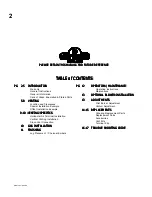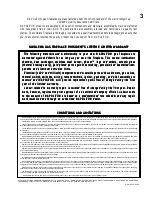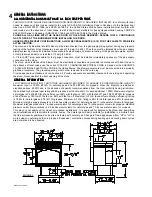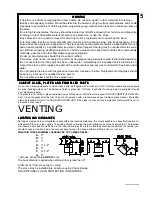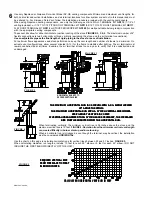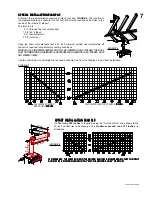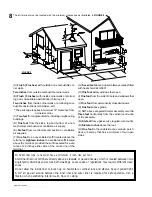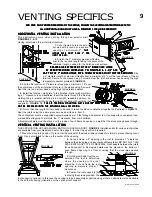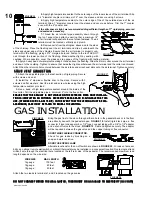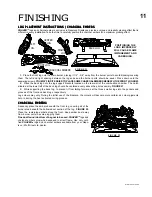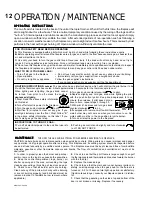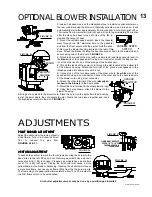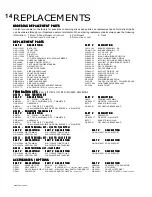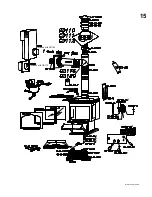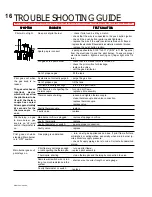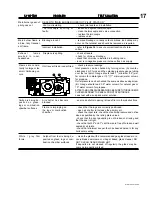
4
WS-415-63 / 11.24.98
GENERAL INSTRUCTIONS
GENERAL INSTRUCTIONS
GENERAL INSTRUCTIONS
GENERAL INSTRUCTIONS
GENERAL INSTRUCTIONS
ALL HORIZONT
ALL HORIZONT
ALL HORIZONT
ALL HORIZONT
ALL HORIZONTAL RUNS MUST HA
AL RUNS MUST HA
AL RUNS MUST HA
AL RUNS MUST HA
AL RUNS MUST HAVE A 1 INCH RISE PER FOOT
VE A 1 INCH RISE PER FOOT
VE A 1 INCH RISE PER FOOT
VE A 1 INCH RISE PER FOOT
VE A 1 INCH RISE PER FOOT.....
THIS GAS STOVE SHOULD BE INSTALLED AND SERVICED BY A QUALIFIED INSTALLER
to conform with local
codes. In absence of local codes, install to the current CAN1-B149 Installation Code in Canada or to the National Fuel
Gas Code, ANSI Z223.1-1988, and NFPA 54-1988 in the United States. Mobile home installation must conform with
local codes or in the absence of local codes, install to the current standard for gas equipped mobile housing CAN/CSA
ZA240 MH Series in Canada or ANSI Z223.1-1988 and NFPA 54-1988 in the United States.
PURGE ALL GAS LINES WITH THE GLASS DOOR OF THE STOVE REMOVED. ASSURE THAT A CONTINUOUS
GAS FLOW IS AT THE BURNER BEFORE INSTALLING THE DOOR.
UNDER EXTREME VENT CONFIGURATIONS, ALLOW SEVERAL MINUTES (5-15) FOR THE FLAME TO STABILIZE
AFTER IGNITION.
The stove and its individual shutoff valve must be disconnected from the gas supply piping system during any pressure
testing of that system at test pressures in excess of 1/2 psig (3.5 kPa). The stove must be isolated from the gas supply
piping system by closing its individual manual shutoff valve during any pressure testing of the gas supply piping system
at test pressures equal to or less than 1/2 psig (3.5 kPa).
A 1/8 inch NPT plug, accessible for test gauge connection, must be installed immediately upstream of the gas supply
connection to the stove.
The stove, when installed with a blower, must be electrically connected and grounded in accordance with local codes. In
the absence of local codes, use the current CSA C22.1 CANADIAN ELECTRICAL CODE in Canada or the ANSI/NFPA
70-1990 NATIONAL ELECTRICAL CODE in the United States. The blower power cord must be connected into a properly
grounded receptacle. The grounding prong must not be removed from the cord plug.
Provide adequate ventilation and combustion air. Provide adequate accessibility clearance for servicing and operating
the stove. Never obstruct the front opening of the stove.
GENERAL INFORMA
GENERAL INFORMA
GENERAL INFORMA
GENERAL INFORMA
GENERAL INFORMATION
TION
TION
TION
TION
FOR YOUR SATISFACTION, THIS STOVE HAS BEEN TEST-FIRED TO ASSURE ITS OPERATION AND QUALITY!
Maximum input is 30,000 BTU/hr for natural gas and 24,000 BTU/hr for propane. When the fireplace is installed at
elevations above 4,500ft, and in the absense of specific recommendations from the local authority having jurisdiction,
the certified high altitude input rating shall be reduced at the rate of 4% for each additional 1,000ft. Maximum output for
natural gas is 25,200 BTU/hr at an efficiency of 84% with the fan on, 83% with the fan off; and 20,400 BTU/hr for propane
at an efficiency of 85% with the fan on, 84% with the fan off. Maximum A.F.U.E. (annual fuel utilization efficiency) rating
is 76.9% for natural gas and 78.16% for propane. Minimum A.F.U.E. rating is 64% for natural gas and 67% for propane.
Minimum inlet gas supply pressure is 4.5 inches water column for natural gas and 11 inches water column for propane.
Maximum inlet gas pressure is 7 inches water column for natural gas and 13 inches water column for propane. Manifold
pressure under flow conditions is 3.5 inches water column for natural gas and 10 inches water column for propane.
This stove is not approved for closet or recessed installations. It is approved for bathroom, bedroom and bed-sitting
room installations and is suitable for mobile homes..The natural gas model is suitable for installation in a mobile home
that is permanently positioned on its site and fueled with natural gas. Change in flame appearance from "HI" to "LO" is
more evident in natural gas than in propane. Expansion / contraction noises during heating up and cooling down cycles
are normal and to be expected.
FIGURE 1


